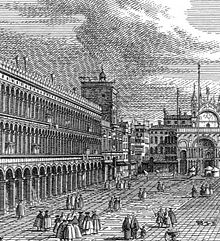
Antonio Visentini
Encyclopedia

Baroque architecture
Baroque architecture is a term used to describe the building style of the Baroque era, begun in late sixteenth century Italy, that took the Roman vocabulary of Renaissance architecture and used it in a new rhetorical and theatrical fashion, often to express the triumph of the Catholic Church and...
that was written by Teofilo Gallacini (1564-1641), but not published until 1767, by the same Venetian publisher, Giovanni Battista Pasquali
Giovanni Battista Pasquali
Giovanni Battista Pasquali was a leading printer in 18th-century Venice, supported by the British consul Joseph Smith , a patron and collector. Pasquali was a scholar himself, who published his own essays as well as finely printed, unpretentious editions for a scholarly readership...
, who brought out Visentini's treatise http://www.polybiblio.com/rappapor/37313.html. Visentini's engravings in his Osservazioni illustrate his proposed modifications correcting Baroque architectural details.
Born in Venice
Venice
Venice is a city in northern Italy which is renowned for the beauty of its setting, its architecture and its artworks. It is the capital of the Veneto region...
, he was a pupil of the widely-travelled Baroque painter Giovanni Antonio Pellegrini
Giovanni Antonio Pellegrini
Giovanni Antonio Pellegrini was a widely-travelled Rococo decorative painter from Venice, where he was born and died...
, who had painted some decors in English country houses at the beginning of the century. The English connection was easily maintained, for Venice was an essential stop on the Grand Tour
Grand Tour
The Grand Tour was the traditional trip of Europe undertaken by mainly upper-class European young men of means. The custom flourished from about 1660 until the advent of large-scale rail transit in the 1840s, and was associated with a standard itinerary. It served as an educational rite of passage...
. On the Grand Canal, Visentini was commissioned to redesign the façade of Palazzo Balbi (1740-1751), the seat of the British Resident Joseph Smith, for whom he worked often. In the 1760s the English architect James Wyatt
James Wyatt
James Wyatt RA , was an English architect, a rival of Robert Adam in the neoclassical style, who far outdid Adam in his work in the neo-Gothic style.-Early classical career:...
studied as an architectural draughtsman and painter with Visentini.
Visentini is better known today as the engraver for Canaletto
Canaletto
Giovanni Antonio Canal better known as Canaletto , was a Venetian painter famous for his landscapes, or vedute, of Venice. He was also an important printmaker in etching.- Early career :...
's first great series of Venetian vedute
Veduta
A veduta is a highly detailed, usually large-scale painting of a cityscape or some other vista....
under the title Urbis Venetiarum Prospectus Celebriores ex Antonii Canal, organised by Consul Smith. The series was begun around 1728 and by the time it was completed in 1735, thirty-eight etchings and engravings had been printed. He taught at the Accademia di Belle Arti in Venice from 1772-78. He painted frescoes at Villa Valmarana in Vicenza
Vicenza
Vicenza , a city in north-eastern Italy, is the capital of the eponymous province in the Veneto region, at the northern base of the Monte Berico, straddling the Bacchiglione...
, for which Gian Domenico Tiepolo painted the figures. He worked with Zuccarelli
Francesco Zuccarelli
Francesco Zuccarelli was an Italian Rococo painter.He was born at Pitigliano, in southern Tuscany, where he initially apprenticed with Paolo Anesi...
on capriccios based on English Palladian villas, again for Consul Smith; some have passed with Smith's collection to the British Royal Collection
Royal Collection
The Royal Collection is the art collection of the British Royal Family. It is property of the monarch as sovereign, but is held in trust for her successors and the nation. It contains over 7,000 paintings, 40,000 watercolours and drawings, and about 150,000 old master prints, as well as historical...
.
He died in Venice in 1782.

